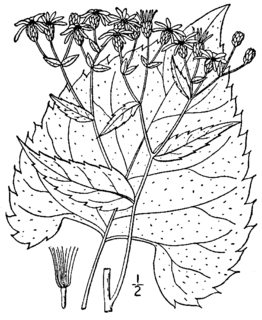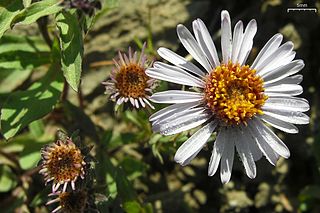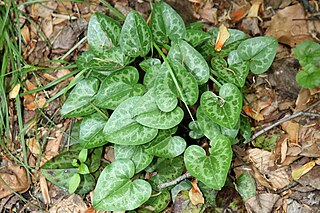
Lilium philadelphicum, also known as the wood lily, Philadelphia lily, prairie lily, or western red lily, is a perennial species of lily native to North America.

Vaccinium uliginosum is a Eurasian and North American flowering plant in the genus Vaccinium within the heath family.

Trillium catesbaei, also known as bashful trillium, Catesby's trillium, or bashful wakerobin, is a species of flowering plant in the family Melanthiaceae. It is found in the southeastern United States where its northern limit includes the Great Smoky Mountains and other parts of North Carolina and Tennessee. Its southernmost natural occurrence is in Escambia County, Alabama. Most of its populations are in the Piedmont from North Carolina to Alabama, under deciduous trees such as American beech, various oak and hickory species, and tulip poplar. Like most trilliums, it prefers moist, humus-rich soil in shade.

Hexastylis arifolia, or the little brown jug, is a perennial wildflower in the family Aristolochiaceae found in the southeastern United States, from Louisiana to Virginia, inland as far as Kentucky. It is considered a threatened species in Florida.

Hexastylis or heartleaf is a segregate of the genus Asarum, in the family Aristolochiaceae. The group comprises ten species endemic to southeastern North America. It is a perennial, evergreen, herbaceous plant with leaves and flowers arising directly from the rhizomes. Hexastylis was once recognized at the level of genus, and in some floral treatments still is, yet it has been shown through morphological and molecular evidence that it is rooted within the genus Asarum.

Trillium cuneatum, the little sweet Betsy, also known as whip-poor-will flower, large toadshade, purple toadshade, and bloody butcher, is a species of flowering plant in the family Melanthiaceae. It is native to the southeastern United States but is especially common in a region that extends from southern Kentucky through central Tennessee to northern Alabama. In its native habitat, this perennial plant flowers from early March to late April. It is the largest of the eastern sessile trilliums.

Eurybia schreberi, commonly called Schreber's aster or nettle-leaved Michaelmas-daisy, is a perennial herb in the composite family. It is native to eastern North America, where it is present in Canada and the United States. The flower heads emerge in the late summer or early fall to show white ray florets and yellow disc florets. It is listed as endangered in Indiana and Iowa, of special concern in Tennessee and possibly extirpated in Maine.

Eurybia hemispherica, commonly known as the southern prairie aster, is an herbaceous plant in the composite family (Asteraceae). It is native to the south-central United States, primarily the lower Mississippi Valley and southeastern Great Plains, from Kansas south to Texas and east to Kentucky, Tennessee, and the Florida Panhandle. Its natural habitat is typically in upland prairies or dry savannas. It is less commonly found in open moist areas, in sandy-loamy soil.

Eurybia merita, commonly known as the subalpine aster or arctic aster, is an herbaceous perennial native to northwestern North America, primarily from the Interior Mountains and Plateau system and Rocky Mountains in Canada, stretching south to Utah and extreme northern California. It is found largely in drier, open areas, generally at subalpine levels in mountains, though in more northern areas it is more common at lower elevations. It is similar in appearance to Eurybia sibirica, but their ranges only overlap near the border between the US and Canada, where E. sibirica is generally found at higher elevations than its relative. The flowers emerge in the late summer and display purple to violet ray florets and pale or creamy yellow disc florets.

Hexastylis virginica, commonly known as Virginia heartleaf, is a prostrate perennial plant in the Aristolochiaceae. It is found in the mideastern United States from Maryland and Virginia in the north, south to North Carolina and Tennessee. The plant is encountered in deciduous and mixed forests. Its flowers emerge in early spring from April through June.

Allium cratericola is a species of wild onion known by the common name Cascade onion. It is endemic to California, where is an uncommon member of the flora in several of the state's mountain ranges, including the northern and southern California Coast Ranges, the western Transverse Ranges, Klamath Mountains, and the Sierra Nevada foothills. Its range covers much of the state, from Riverside County to Siskiyou County.

Liatris cylindracea is a plant species in the aster family. It is native to eastern North America, where its populations are concentrated in the Midwestern United States. It is found in habitats such as prairies, limestone and sandstone outcroppings, bluffs, barrens, glades, woodlands and dunes.

Solidago gigantea is a North American plant species in the sunflower family. Its common names include tall goldenrod and giant goldenrod, among others.

Hexastylis naniflora is a rare species of flowering plant in the birthwort family known by the common name dwarf-flowered heartleaf. It is endemic to the Piedmont region of the United States, where it is limited to a small area straddling the border between North Carolina and South Carolina. It is a federally listed threatened species.

Draba ramosissima, the branched draba, is a species of flowering plant in the family Brassicaceae. It has a restricted range, being found only on calcareous cliffs of the Appalachian Mountains, the Kentucky River Palisades, and Middle Tennessee. It is a small perennial herb with racemes of white flowers in the spring.

Solidago rigida, known by the common names stiff goldenrod and stiff-leaved goldenrod, is a North American plant species in the aster family (Asteraceae). It has a widespread distribution in Canada and the United States, where it is found primarily east of the Rocky Mountains. It is typically found in open, dry areas associated with calcareous or sandy soil. Habitats include prairies, savannas, and glades.

Triantha glutinosa is a species of flowering plant in the Tofieldiaceae family. It is commonly known as the sticky false asphodel, sticky tofieldia or northern bog asphodel, is a species of flowering plant in the tofieldia family.

Cardamine flagellifera, commonly known as Blue Ridge bittercress, is a species of herbaceous plant in the mustard family. It is native to eastern North America, where it is found primarily in the southern Blue Ridge. It is a perennial that produces white flowers in the spring.

Minuartia glabra, commonly called Appalachian stichwort, is a species of flowering plant in the carnation family (Caryophyllaceae). It is native to the eastern United States, where it has a scattered distribution.
Silphium wasiotense, commonly called Appalachian rosinweed, is a species of flowering plant in the aster family (Asteraceae). It is native eastern to North America, where it is endemic to the Cumberland Plateau of Kentucky and Tennessee. Its natural habitat is in dry open woodlands. It is considered rare throughout its range.



















